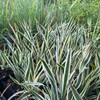
Yucca 'Ivory Towers' - ADAM'S NEEDLE 'IVORY TOWERS' (Variegated Yucca)
Evergreen structural plant that adds drama to your flower bed.
Tough as nails, tolerant to various growing conditions, heat, humidity, drought, lean soil and even some shade.
Disease, trouble-free and long-lived perennial.
Blooming Time: white flowers arranged in large panicles appear in early to mid summer (late May to June/early July, depending on your zone)
Size: 2'-3' tall x 2-3' wide, in time grow into wider clumps. Height with flowers 4-5'. Moderately to slow growing plant
USDA Zones: 5-9
Culture: full sun, half sun, half shade (yucca is surprisingly tolerant to some shade!). Adaptable to virtually any soil conditions, excluding constantly wet or waterlogged soils. Prefers somewhat drained soils, but will grow anywhere, even in the clay. Average, loamy, also poor quality soils (gritty, rocky, sandy, infertile).
Moisture Needs: average (medium) to medium-dry to dry, very drought tolerant.
Origin: Yucca 'Ivory Towers' is sometimes mentioned as Yucca flaccida (native to eastern and southeastern USA and parts of Midwest), sometimes as Yucca filamentosa (native to south eastern USA).
Black walnut tolerant: yes
Deer/Rabbit Resistant: yes / yes
Attracts Butterflies or Pollinators: yes,small amount of specialized insects, moths are the main pollinator
Attracts Hummingbirds: sometimes Yucca is mentioned to attract hummers and small song birds
Pot Size: square 3.5" x 4" deep perennial pot
Plant combinations: Naturally looks very good with rocks.Drier flower beds, cottage gardens, exotic, xeric, large rock gardens, sloped and terrase gardens, eclectic, modern gardens, deer resistant plantings, naturalistic gardens, coastal gardens, or even edges of rain gardens. The best combinations are with smaller-leaved, smaller, groundcovering plants, succulents and fine-leaved grasses that support the majestic and unusual look. But looks well even with larger plants.
Good companions can be Artemisia, Agastache, Catanache caerulea, Eriogonum, Eryngium, Euphorbia, Gaillardia, Gypsohilla repens, Nepeta, Lavandula, Linum lewisii, Opuntia, Phlox subulata and other creeping phloxes, Scabiosa, various Salvia, Veronica. But can be combined with many plants on the average to drought tolerant scale like Achillea, shorter Aster, Echinacea, Paeonia, bearded Iris, Perovskia, Platycodon, Sedum and medium to taller grasses (Muhlenbergia, shorter Panicum, Pennisetum, Sporobolus, Schizachyrium).
Picture copyright: US Perennials

Yucca 'Ivory Towers' - ADAM'S NEEDLE 'IVORY TOWERS' (Variegated Yucca)
Evergreen structural plant that adds drama to your flower bed.
Tough as nails, tolerant to various growing conditions, heat, humidity, drought, lean soil and even some shade.
Disease, trouble-free and long-lived perennial.
Blooming Time: white flowers arranged in large panicles appear in early to mid summer (late May to June/early July, depending on your zone)
Size: 2'-3' tall x 2-3' wide, in time grow into wider clumps. Height with flowers 4-5'. Moderately to slow growing plant
USDA Zones: 5-9
Culture: full sun, half sun, half shade (yucca is surprisingly tolerant to some shade!). Adaptable to virtually any soil conditions, excluding constantly wet or waterlogged soils. Prefers somewhat drained soils, but will grow anywhere, even in the clay. Average, loamy, also poor quality soils (gritty, rocky, sandy, infertile).
Moisture Needs: average (medium) to medium-dry to dry, very drought tolerant.
Origin: Yucca 'Ivory Towers' is sometimes mentioned as Yucca flaccida (native to eastern and southeastern USA and parts of Midwest), sometimes as Yucca filamentosa (native to south eastern USA).
Black walnut tolerant: yes
Deer/Rabbit Resistant: yes / yes
Attracts Butterflies or Pollinators: yes,small amount of specialized insects, moths are the main pollinator
Attracts Hummingbirds: sometimes Yucca is mentioned to attract hummers and small song birds
Pot Size: square 3.5" x 4" deep perennial pot
Plant combinations: Naturally looks very good with rocks.Drier flower beds, cottage gardens, exotic, xeric, large rock gardens, sloped and terrase gardens, eclectic, modern gardens, deer resistant plantings, naturalistic gardens, coastal gardens, or even edges of rain gardens. The best combinations are with smaller-leaved, smaller, groundcovering plants, succulents and fine-leaved grasses that support the majestic and unusual look. But looks well even with larger plants.
Good companions can be Artemisia, Agastache, Catanache caerulea, Eriogonum, Eryngium, Euphorbia, Gaillardia, Gypsohilla repens, Nepeta, Lavandula, Linum lewisii, Opuntia, Phlox subulata and other creeping phloxes, Scabiosa, various Salvia, Veronica. But can be combined with many plants on the average to drought tolerant scale like Achillea, shorter Aster, Echinacea, Paeonia, bearded Iris, Perovskia, Platycodon, Sedum and medium to taller grasses (Muhlenbergia, shorter Panicum, Pennisetum, Sporobolus, Schizachyrium).
Picture copyright: US Perennials






